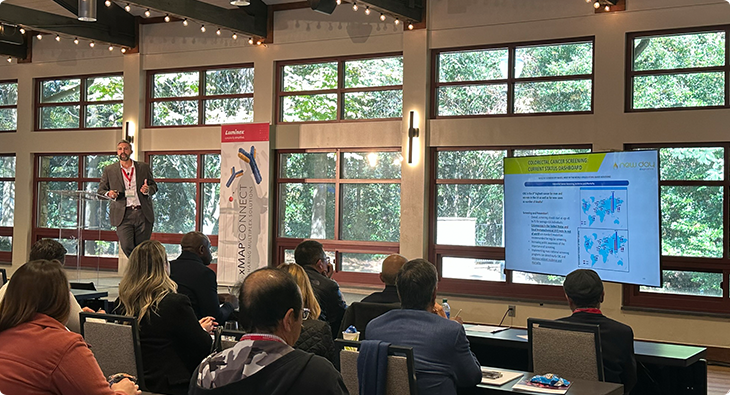At xMAP® Connect Atlanta, Customers Highlighted the Benefits of Multiplexing Across Multiple Applications
From academic to commercial, using their own developed assays or LuminexPLORE Lab services, xMAP® end users showcased a wealth of applications for multiplex assays
By: Lauren Whitman
At our most recent xMAP® Connect event in Atlanta, GA., we had the great privilege of hearing from xMAP end users about how Luminex’s xMAP® Technology is making a difference in their research and development. We’d like to thank everyone who attended, and for those who couldn’t be there in person, we’ve summarized some of the event highlights.
The year in review
Kicking off the day was our own Sherry Dunbar, Senior Director of Global Scientific Affairs Programs, with a comprehensive review of five notable publications citing xMAP Technology in 2023, representing the breadth of the technology used across various applications. In the first three quarters of the year, there were more than 2,500 papers citing our technology — contributing to a total of more than 70,000 papers since xMAP Technology was first commercialized. Dr. Dunbar’s presentation focused on the following paper topics:
- A look at the cytotoxic activities of CD8+ T and natural killer cells from lung cancer patients before and after chemotherapy to understand whether changes in cell function are associated with clinical response
- A broad effort to identify cytokine signaling patterns linked to various diseases, including COVID-19, Kawasaki disease, and more
- Assessment of an xMAP-based assay on nearly 500 patient samples for serological mpox testing to help confirm cases and pinpoint transmission chains during an outbreak
- Characterization of age-associated B cells from patients with varying immunological disorders and an analysis of how that affects the long-term response to COVID-19 vaccination
- A duplex serological multiplex assay for simultaneous detection of IgA and IgG antibodies to Epstein-Barr virus using the xMAP INTELLIFLEX® System
Optimizing cytokine analysis with xMAP Technology
From the University of Minnesota, Laura Hocum Stone spoke about work performed in the Preclinical Research Center to optimize the value of testing on animal models for preclinical trials. Her presentation focused on how her team is conducting cytokine analysis to generate accurate, reliable data from nonhuman primates. Cytokines are easily accessed in circulating fluids and can be studied in low sample volumes, improving conditions for animals in these important trials. They evaluated commercially available cytokine assays, selecting an xMAP-based option with an optimized protocol that yielded excellent results.
Evaluating SARS-CoV-2 and other infectious diseases
We also heard about several exciting efforts related to infectious diseases. Mukesh Kumar from Georgia State University spoke about using xMAP cytokine and chemokine assays to study neuroinflammation from infections of COVID-19, Zika, Powassan virus, and more. The approach works well with a variety of sample types and generates rapid results from low-volume samples. In another presentation, Ian Davis from the US Army Medical Research Institute of Infectious Diseases reported on the development of an assay for the rapid detection of mpox virus antigen. The two clade-specific xMAP-based assays were validated, and the team hopes to translate them to lateral-flow format in the future. In one more infectious disease presentation, Dylan George from the University of Nebraska Medical Center described a project designed to measure the humoral response to SARS-CoV-2. The resulting HumorX test is economical, reliable, and easy to use for community screening based on fingerstick blood samples.
xMAP Technology enables other biotechnology companies
We also enjoyed hearing from those representing various biotech companies, including several startups, that rely on xMAP Technology to develop and deliver better products. For example, Ira Herman at Precision Healing spoke about using xMAP assays to evaluate wounds that don’t heal easily. By testing samples of wound exudate with custom 15-plex and 27-plex assays developed with the LuminexPLORE Lab team, the company aims to improve and personalize healing treatments for challenging wounds.
Another startup, EmitBio, is developing a handheld medical device for at-home treatment of respiratory infections that uses specific light wavelengths to eliminate pathogens. Jacob Kocher described how the company used xMAP-based assays to study cytokine response, and then used that data to prioritize or rule out certain wavelengths (for instance, they found that 425 nm light works broadly against variants of SARS-CoV-2).
In another presentation, William Shea from ImmunoProfile (a Luminex partner) spoke about the development of an xMAP assay designed for rapid, cost-effective antibody status for 11 different diseases to help people understand their immunization status and history. The assay, which has performed well in validation studies, is designed to be run from fingerpick samples that can be collected at home by customers and mailed to the lab for analysis.
At Totus Medicines, xMAP Technology is being used to support a pharmacodynamics assay to validate the clinical performance of a molecule designed to inhibit PI3Ka, one of the most mutated oncogenes. Raymond Mak described working with the LuminexPLORE Lab to convert assays originally developed with western blot technology to a dual-reporter xMAP assay for the xMAP INTELLIFLEX DR-SE System that would measure the percentage of PI3Kα that bound to the candidate drug.
Finally, Jason Liggett from New Day Diagnostics (a Luminex partner formerly known as EDP Biotech) spoke about his company’s goal of increasing compliance with colon cancer screening, and how a blood-based test could accomplish that. The company developed ColoPlex™, an xMAP-based assay covering 16 serological protein biomarkers and validated it in a patient cohort of nearly 2,000 samples. The assay can be paired with standard stool-based immunochemical tests to provide more reliable early-stage detection of colon cancers.
At all our xMAP Connect events globally, we find ourselves inspired by the creativity with which scientists deploy our multiplexing technology, and the Atlanta meeting was no exception. We congratulate all our speakers on their terrific work!
COMING SOON!
The Atlanta presentations will be available for your on-demand viewing on our website in early 2024. Keep an eye on your inbox for details! In addition, our team is currently hard at work planning the next xMAP Connect meeting in 2024, so be sure to regularly check our website for updates!
In the meantime, stay in the loop with Luminex and the multiplexing community throughout the year with these helpful resources available at your fingertips:
- Learn how to design your own assays with the xMAP Cookbook.
- Access our latest white papers and search through an extensive database of over 77,000 publications citing xMAP Technology.
- Browse 1,200+ commercial research partner kits with the xMAP Kit Finder.
- Keep up to date on the latest xMAP news with our blog series.
- Be among the first to know about our future Luminex events by subscribing to our xMAP Resource Round-Up monthly newsletter.
- Be sure to subscribe to xMAP Insights magazine.
- Look out for new updates to xMAP INTELLIFLEX software.
- Discover how developing and testing custom assays with the LuminexPLORE Lab can help get you to market faster.
- Remember to follow us on LinkedIn and YouTube!

